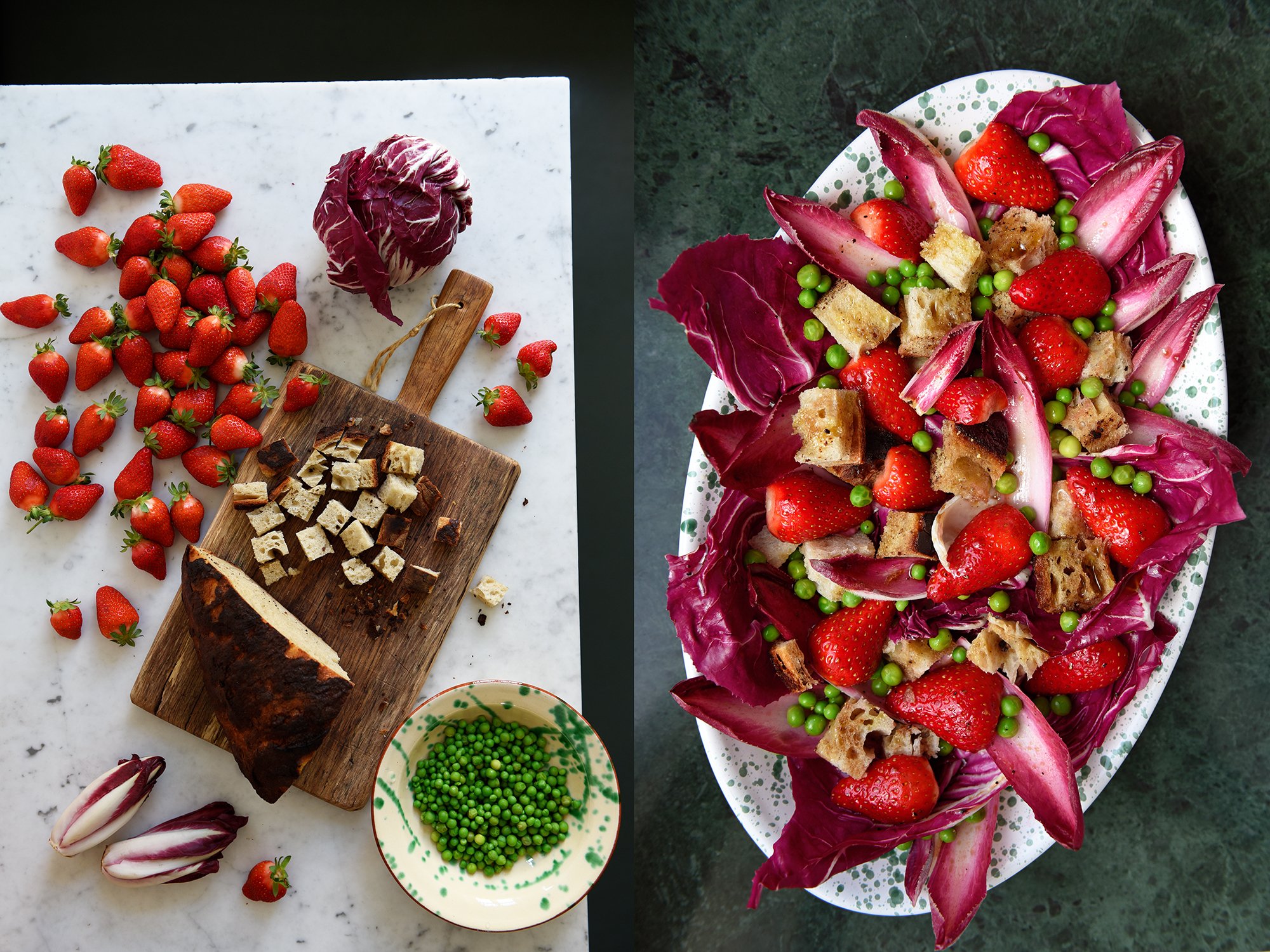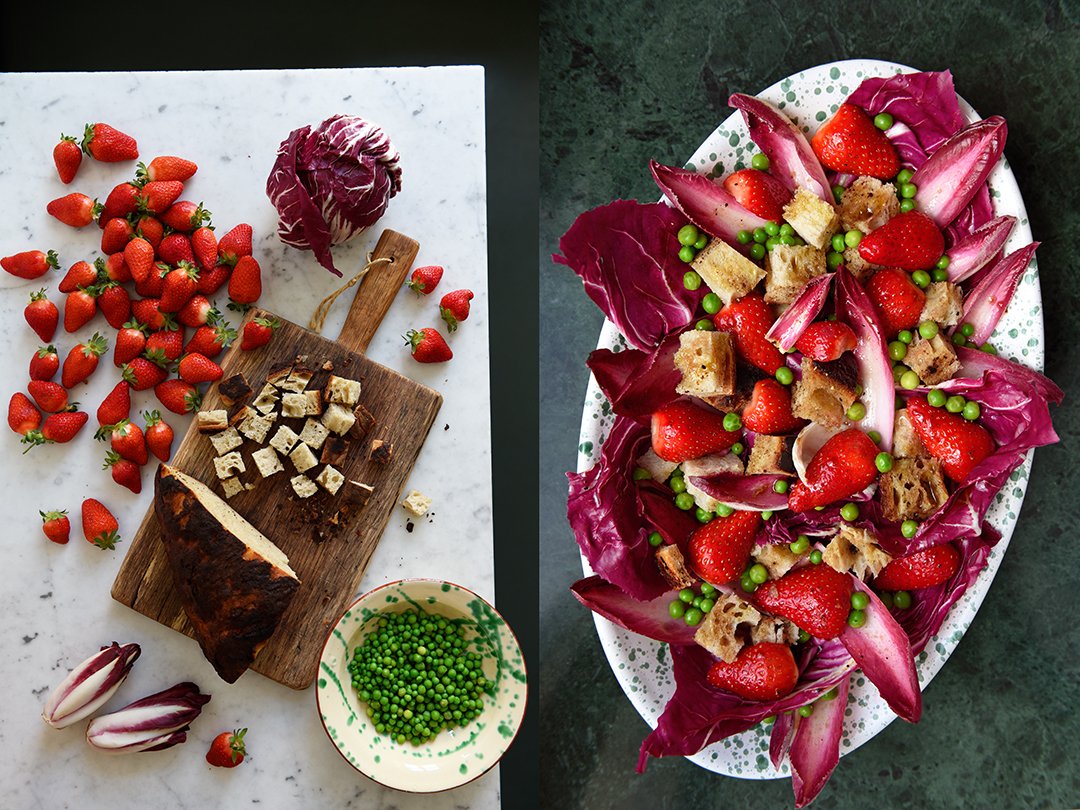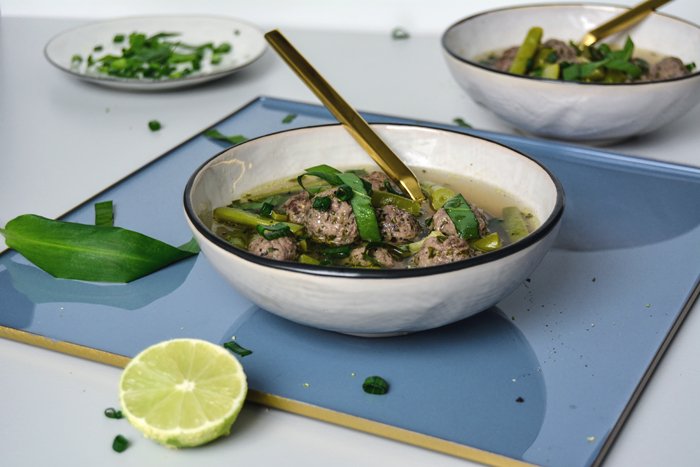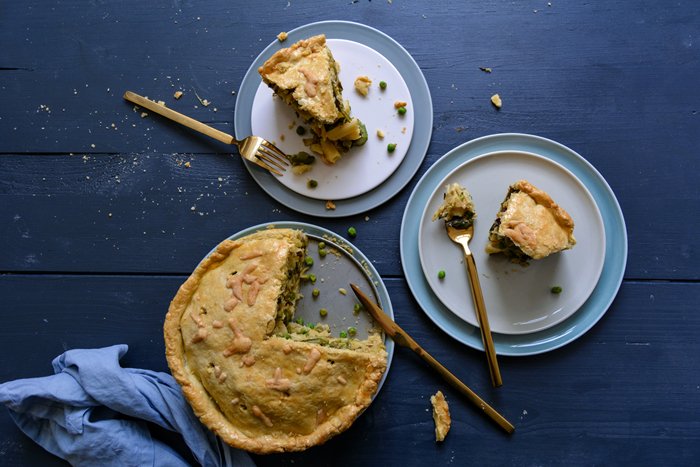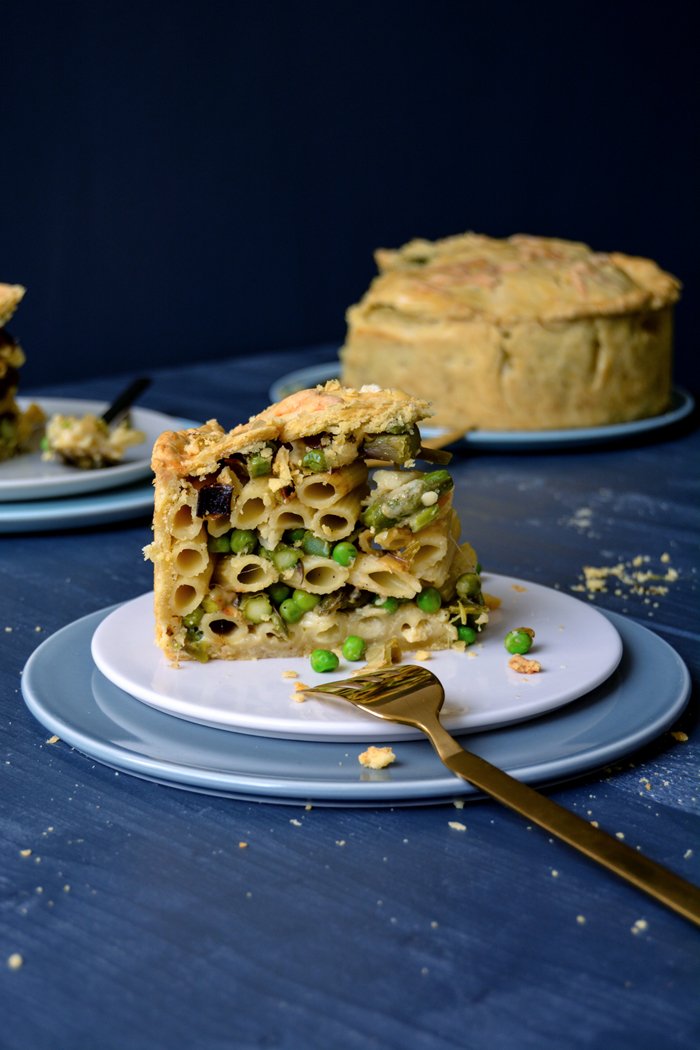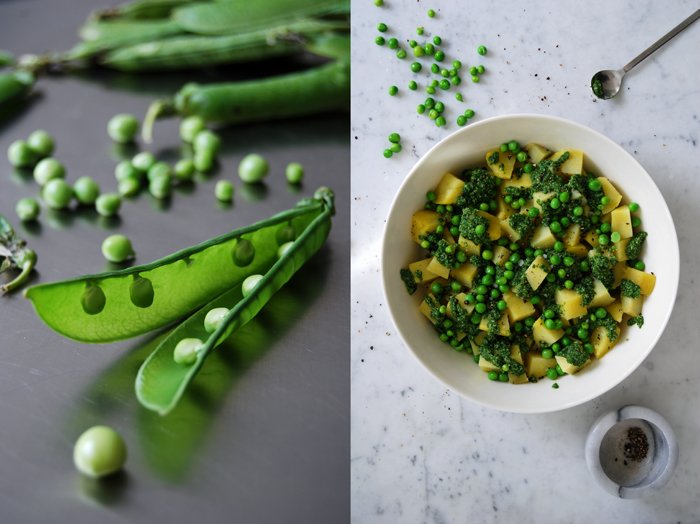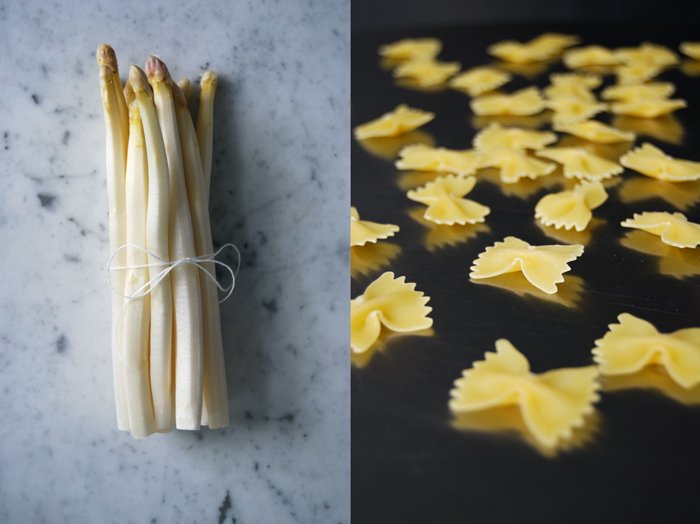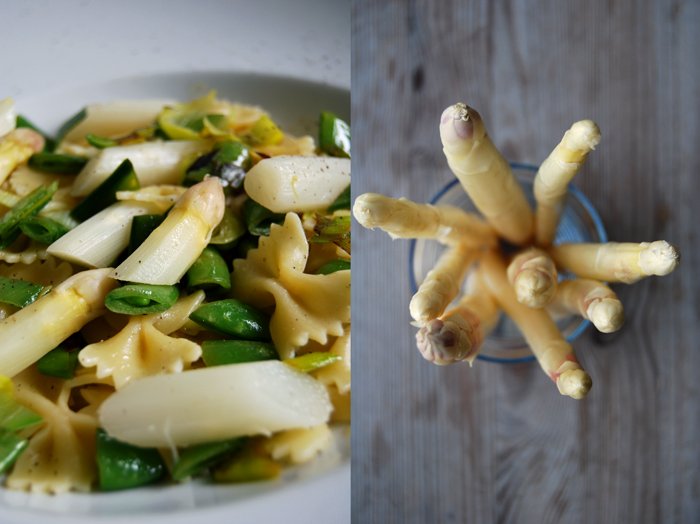Summer Panzanella
I fell in love with panzanella when I was about five or six years old. We used to spend our summers in Tuscany, in a tiny old town close to Lucca. These holidays sparked my forever longing for the Mediterranean, for its pure and simple way of cooking, and for salads made with old bread. The taste of stale bread, soaking up the oily juices of a dark vinaigrette, tossed with deep red, ripe tomatoes and fleshy basil leaves became a memory so strong that it shaped my palate and my future cooking as an adult.
It was then that, without consciously noticing, I understood that a handful of good produce and products can create magic on a plate. It wasn’t luxurious, it was frugal, it wasn’t labor-intensive, it was very easy to prepare. And it was adventurous: I picked the tomatoes together with my Mama from the vegetable garden behind the house where we stayed. The garden, picking vegetables under the burning hot Italian sun, using old/ stale bread and not wasting it, preparing the dish together with my mother, bare-footed on clay tiles, setting the table with colorful, heavy Tuscan ceramics - all this became me, as a cook and as a person.
Now, you can find theses ceramics in my kitchen in Berlin, and although I don’t have a vegetable garden, my cooking is still very much produce-based and circling around comforting and frugal dishes (more and more even these days). And my love for panzanella is unbroken, as strong as ever.
So during our holidays in Tuscany, we ate the basic version with tomatoes and basil almost every day. Over the years, I’ve tried other recipes, with fish and seafood even, but I find that bread salads focussing on fresh vegetables excite me the most. I also like to add fruit sometimes. I even have three panzanella recipes in my book 365, with cherries and Stilton, one with berries and bacon (you can find the link below), and there will be a couple more in my new book NOON (not the one I’m sharing today).
Very often (when I’m not working on a cookbook), I don’t plan the recipe in advance but just look in my fridge and on the kitchen counter and then decide what kind of panzanella I’ll throw together. Just leftovers, staying frugal, and true to its core.
So when I had a loaf of sourdough bread lying around, slowly losing its sponginess (I never use completely stale bread for my panzanella, as you’d have to soak it in water first, which I don’t like), I knew what I would turn that into. Crisp leaves of radicchio and red Belgian endive - yellow endive works just as well but I love the drama that the red one adds - bring in a bitter note, green peas and ripe strawberries make it sweet and juicy. Stilton would have fit too (it always fits) but there was none in the fridge, so I went back to my panzanella roots: work with what you have right in front of you.
Here’s the recipe for my Berry and Bacon Panzanella with Rosemary.
MY NEW BOOK
NOON: Simple Recipes for Scrumptious Midday Meals and More
ON SALE SEPTEMBER 2023
YOU CAN PRE-ORDER NOON HERE
Support local: pre-order from your neighborhood bookstore
Summer Panzanella
Serves 1
For the salad
1 small handful fresh or frozen peas
3 large radicchio leaves, torn
1 red or yellow Belgian endive, leaves separated
8 ripe strawberries, hulled and cut in half
1 large, thick slice of white bread (ideally sourdough bread), cut into chunky cubes
For the dressing
3 tablespoons olive oil
1 tablespoon balsamic vinegar
1 tablespoon white balsamic vinegar
fine sea salt
ground pepper
For the salad, bring salted winter in a small saucepan to a boil and blanch the peas for 1 minute. Drain the peas, briefly rinse with cold water, and let them cool for 2 minutes then set aside.
For the dressing, whisk together the olive oil and both vinegars in a small bowl and season to taste with salt and pepper.
On a large plate or platter, layer the radicchio leaves, the whole Belgian endive leaves, strawberries, bread, and peas. Drizzle with the dressing and enjoy immediately (which I do) or let it soak for 15 minutes.
Ramp and Prosciutto wrapped Monkfish with Spring Peas
I didn't have many cookbooks when I was younger, I learned all about cooking from my mother. She's my mama bird in the kitchen, I just watch and follow her. Then, in my late teens, she gave me my first cookbook, a detailed introduction to the most important basic techniques covering everything from eggs to soups, meat, seafood, and vegetables. It felt like she wanted to be sure that I wouldn't starve when I moved out. The book was published in the 80's and beautifully photographed. Quite minimal. I think, in regards to food photography, this book influenced my style of capturing food in pictures more than any other publications.
It was my only cookbook for a long time, but I collected and wrote down recipes myself whenever I got the chance to sneak a kitchen classic from a friend or my family. Even in restaurants, I was never shy to ask, if they'd share a recipe with me (the ones that really hit me). This strategy led to a bursting folder packed with notes, snippets, and sheets torn out of magazines. I still haven't cooked and baked all of the treasures collected in more than 30 years. It's a steadily growing project.
As I got into collecting cookbooks, Jamie Oliver's books were one of the first added to the shelves. First as a present from friends, but later on I bought a few myself. I liked his style of playing with food. I was in my early twenties, I had seen and tasted many German, French, and Italian traditional classics cooked to perfection, by my mother and in friend's kitchens, or at restaurants. But I felt like a younger voice. And Jamie's voice felt just right at that time. In the end, I might have only cooked about 15 of his creations in all those years, but he inspired me a lot. And at least 5 of his recipes became staples that I still embrace today.
There's one recipe that I've been wanting to try for more than 15 years. And again, I didn't use it to follow, but to play with: Jamie wraps monkfish filets in prosciutto spread with pesto. It's so simple, it looks stunning. As spring is in the air, or at least the smell of ramps as you enter the woods, I decided to wrap my firm white fish fillet in ramp leaves and prosciutto di Parma. Thanks to Jamie, the cooking time and temperature were perfect. The fillet was tender yet firm. And the wrapping was spot on: green, fresh, and slightly salty.
If you're still looking for an Easter menu, what about skipping the traditional lamb roast and go for seafood? This dish is so easy, serve it with a bowl of lemony ramp peas and baguette (for the lazy ones like me) or Mediterranean mashed potatoes (either from my book, or try this recipe). And what about an eggnog sponge cake for dessert?
Have a wonderful Easter time with your loved ones!
xx
Ramp and Prosciutto wrapped Monkfish
Serves 2
olive oil
monkfish fillet, a thick center piece, 250-300g / 9-11 ounces
fine sea salt
ground pepper
prosciutto di Parma (or San Daniele or Serrano) 10 very thin slices
fresh ramps leaves, a small bunch
peas, fresh in shells (about 400g / 15 ounces) and peeled, or frozen (170g / 6 ounces)
freshly squeezed lemon juice, 1-2 teaspoons
Preheat the oven to 200°C / 400°F (conventional setting) and brush the bottom of a baking dish with olive oil.
Cut the monkfish in half (lengthwise) and, using your hands, coat it in olive oil and season with salt and pepper.
On a large chopping board, spread out half the prosciutto (overlapping slices). Arrange a layer of ramp leaves on top (laying across the prosciutto), then lay one half of the monkfish on top (see 5th picture). Roll and wrap the fish tightly and transfer to the oiled baking dish. Prepare the second fillet the same way and lay next to the first fish wrap. Brush the prosciutto with olive oil and bake in the oven for about 15 minutes or until the fish is tender.
While the fish is baking, prepare the peas: Cut 12 ramps leaves into thin strips, set aside. Cook the peas in plenty of salted boiling water for 1 minute or until al dente. Drain and briefly rinse with cold water. In a small saucepan, heat a splash of olive over high heat, add half the chopped ramps, and take the pan off the heat. Stir in the peas and lemon juice and season with salt and pepper to taste.
When the fish is done, using a sharp kitchen knife, cut the fillets into thick slices and divide between 2 plates. Serve with the peas sprinkled with the remaining chopped ramps, crunchy baguette, and chilled white wine.
Crêpe love Part II: Green Shakshuka Crêpes and fantastic news
Sometimes life does funny things, these unexpected surprises that hit you with such impact that you can't even say a word anymore. Short circuit in the mind. A few days ago, I experienced one of these moments and I'm still recovering from this mental hangover. If I had written this post back then when it hit me, I would have shouted out the news hysterically, but I calmed down, so today, it's a civilised announcement:
The James Beard Foundation has nominated the Eat In My Kitchen book for the prestigious James Beard Award 2017 in the General Cooking category, alongside Ina Garten's Cooking for Jeffrey and Cook's Science's How to Unlock Flavor in 50 of Our Favorite Ingredients!
This is crazy, I thought I was going to faint! Thanks to my man I didn't loose it completely. So what can you do, when life does these funny things that make you speechless? You just sit there, quietly, silently, wait until it sinks in - and you book a flight to New York where the award ceremony is going to take place in April. I'll keep you posted.
Once my adventurous trip was booked and I felt my stomach again, I made crêpes. You remember that, last week, I shared my new favourite pancake passion with you: crêpe au citron. When I went to Normandy and I found that wonderful Crêperie in the village of Le Touquet, I new there would be lots of thin crêpes on my own kitchen table in the near future. After the citrusy dessert, we can move on to the main course: green shakshuka crêpes. I didn't find this particular recipe on the menu of my little French village restaurant, but another hearty treat that was also a pure pleasure. It was a galette (buckwheat crêpe) filled with ham, cheese, and a soft egg. It was the best comfort food you can think of, especially when you can smell a salty breeze in the air and you have an endless long beach right in front of you.
Personally, I prefer a normal crêpe over a galette, it works just as well in combination with a savoury filling (however, in my recipe below you find both options). First I just wanted to share the classic with you - ham and cheese - but then I saw a green shakshuka somewhere and I could already see it in my mind, wrapped in a crêpe. As the pancake filling shouldn't be too soggy, I only went for peas, spring onion, and parsley stirred in cumin-garlic oil. Arugula leaves and Gruyère cheese sprinkled over the cracked egg cooking slowly on top of the crêpe, and it was done. It's aromatic and fresh, slightly eggy with a soft hint of cumin, and the greens taste like spring. I seasoned it with another souvenir that I brought home from France: peppery Piment d'Espelette (Gorria chilli pepper powder).
We enjoyed this green beauty for lunch and dinner, but I can also see it on a Sunday breakfast table!
Green Shakshuka Crêpes
If you prefer to make galettes (buckwheat crêpes), replace half the plain flour with buckwheat flour.
Makes about 4 large crêpes
For the crêpes
plain flour, sifted, 130g / 1 cup
granulated sugar 1/2 tablespoon
fine sea salt 1/8 teaspoon
organic eggs 2milk 250ml / 1 cup and 1 tablespoon
butter, to cook the crêpes
For the filling
olive oil 2 tablespoons
large garlic clove, cut in half, 1
ground cumin 1/4 teaspoon
fresh or frozen green peas, blanched for 1/2 minute, rinsed, and drained, 200g / 7 ounces
spring onions, thinly sliced, 2
fresh flat-leaf parsley leaves, roughly chopped, a small handful
fine sea saltground pepper
organic eggs 4
aromatic hard cheese (like Gruyère), finely grated 80g / 3 ounces
arugula (rucola), a small handful
Piment d'Espelette (optional)
For the crêpes, in a large bowl of a stand mixer fitted with a whisk, mix the flour, sugar, salt, eggs, and milk until smooth; let the batter sit for about 10 minutes (at room temperature) to 1 hour (in the fridge).
For the filling, in a medium saucepan, heat the olive oil, garlic, and cumin over high heat and cook until it starts sizzling. Take the pan off the heat immediately and stir in the peas, 3/4 of the spring onions, and the parsley. Season with salt, pepper, and additional cumin to taste and set aside.
In a large, heavy or non-stick pan, melt half a teaspoon of butter on medium-high heat. Pour in a large ladle of the batter, holding the pan in your hand and turning it so that the batter spreads evenly and thinly. Cook the crêpe for 30-60 seconds or until golden, flip around, and take the pan off the heat. Turn the heat down to medium-low. Carefully crack an egg in the middle of the crêpe, gently swirl the egg white a little so that it spreads a bit, don't break the egg yolk. Spread 1/4 of the cheese and 1/4 of the shakshuka filling, and 1/4 of the arugula around the egg yolk (see 1st picture) and fold up 4 sides of the crêpe so that your end up with a square shape. Leave the egg yolk uncovered. Put the pan back on the heat and let the egg white set, the yolk should stay runny. If the bottom of the crêpe gets too dark, turn down the heat. Sprinkle with 1/4 of the remaining spring onions and season with Piment d'Espelette or ground pepper to taste; serve immediately.
Continue cooking and filling 3 more crêpes, you should always melt 1/2 -1 teaspoon of butter in the pan before you cook the next crêpe. You can use any remaining batter (made of plain flour) to make crêpe au citron.
Bon appétit!
Green Minestrone with Lime-Arugula Meatballs
Sometimes I am asked by a reader to come up with a certain recipe. Quite often it's a dish connected to a childhood memory of theirs, a food experience saved many years ago, and now they're hoping to find this specific flavour again. But it's a tricky thing, it's almost impossible to relive something as an adult and expect the same satisfaction that we felt back then when we were young.
I used to love Dutch coconut sheets for breakfast, which is as weird as it sounds. This is compressed dessicated coconut, pressed into thin sheets and, to make it even more appealing, they were either pink or pale white. I was obsessed with them. After a culinary break from this delicacy, I tried them again years later and I was so disappointed. But there's another Dutch classic, which still lives up to my memories, and I enjoy it with the biggest passion whenever I pull it out of my oven: sticky honey cake.
At the end of this winter, I got asked to share a traditional German hot chocolate recipe, which my reader, who lives in the US, connects with the time he spent in Germany as a child. Somehow, I never felt in the mood for it, and my hot chocolate is also a rather simple creation made of milk, unsweetened cocoa powder, and ground cinnamon and cardamom, which is not a traditional German take on this drink. I'm sorry, I'll try to write about it next winter.
But last week, someone dropped a comment on Instagram, telling me that I haven't made a soup in a long time - and this person was right! She lives in Asia and asked for a soup that she can have with her morning rice. I don't think that someone who lives in Asia, needs a German girl to tell her how to make a fragrant broth with ginger, spices, and lemon grass, so I thought about something that I could share from my background. Our summers spent in Malta made me fall for minestrone, and when I cook this warming soup with just green vegetables - like fresh beans, peas, and zucchini - it tastes like spring. To turn it into a full lunch, I add tiny meatballs refined with lots of chopped arugula and lemon zest. The strong aroma of the citrus fruit reminds me of the Mediterranean but at the same time, it adds the same lemony freshness that you know from a clear broth made with ginger. Enjoy!
Green Minestrone with Lime-Arugula Meatballs
Serves 2-4
For the meatballs
ground beef 400g / 14 ounces
fresh arugula leaves, finely chopped (with a knife or in a blender), 1 large handful / 50g
zest of 1 lime (1 heaping teaspoon)
garlic, crushed, 2 cloves
fine sea salt 1 teaspoon
a generous amount ground pepper
For the soup
olive oil
garlic, cut in half, 1 clove
green vegetables (a mix of trimmed green beans, peas, and zucchini), beans and peas cut into bite size pieces, about 350g / 12 ounces
vegetable broth, hot, 1l / 4 1/4 cups
freshly squeezed lime juice 1 tablespoon
bay leaf 1
fine sea salt
ground pepper
For the topping
ramp leaves, thinly sliced, 2 and / or spring onion, thinly sliced, 1
For the meatballs, in a large bowl, combine the ground beef, chopped arugula, lime zest, garlic, salt, and pepper and mix until well combined. Wet your hands and form the mixture into tiny meatballs.
For the soup, in a large saucepan, heat a splash of olive oil over medium heat. Add the garlic and cook, stirring, for about 1 minute. Add the vegetables, stir, and cook for 1 minute. Add the broth, lime juice, and bay leaf, season with salt and pepper to taste, and bring to the boil. Add the meatballs and bring to the boil again. Reduce the heat to medium, cover with a lid, and simmer for 4 minutes. Split 1 meatball to check if it's done. Season the soup with salt, pepper, and additional lime juice to taste.
Serve the soup in deep bowls, sprinkled with ramps and / or spring onion, and enjoy warm.
Spring Timpana - Maltese Pasta Pie with Asparagus, Peas, and Leeks
Yesterday's excitement called for lots of carbs - and a glass of wine! It was a day packed with too many emotions to handle. After sharing the cover of my book and the Amazon pre-order links here on the blog, I felt overwhelmed by all the sweet emails and messages I got from all over the world. I needed good, solid, rustic food for dinner to calm me down. I made a dish that is so packed with carbs that it actually feels a little weird, but it's also packed with flavour and comfort, so it makes sense. I baked a springy Maltese pasta pie, also known as Timpana. I introduced you to this Maltese street food classic a few months ago and the response to the recipe was crazy.
Timpana is basically short pasta stuffed into a buttery pastry shell. Usually, it's enriched with Bolognese, which is nice but it can get a little boring if you've eaten it for years, so last time I made it I went for a meat-free Mediterranean filling of zucchini, eggplant, tomato, and basil. It was so good that I thought I'd never need another filling ever again. But then spring came around the corner with all its pretty greens. Wouldn't it be nice to see green asparagus, sweet peas, and leek inside this pie beauty? I didn't have to think about it twice. I went to the grocery store, put all the vegetables in my bicycle's basket, and once home, I turned on the oven.
It's still a little weird for me to look at this combination of penne and shortcrust in a rational way but maybe this dish shouldn't be overanalyzed. It simply feels and tastes good, and after the first bite, my mind and emotions were at ease again: I felt so happy and thankful to have the eat in my kitchen blog and book in my life, both of them connect me with so many people all over the world and bring so many fantastic experiences into my life.
Spring Timpana - Maltese Pasta Pie with Asparagus, Peas, and Leeks
You'll need a 20 1/2cm / 8″ springform pan.
Serves 4-6
For the filling
penne pasta 250g / 9 ounces
green asparagus, trimmed, about 500g / 1 pound
peas, fresh or frozen, 200g / 7 ounces
olive oil
leek, thinly sliced, 200g / 7 ounces
Dijon mustard
3 teaspoons
fine sea salt 1 teaspoon
ground pepper
organic egg 1
Parmesan, freshly grated, 80g / 3 ounces for the filling plus 1 tablespoon for the topping (or 100g / 3 1/2 ounces for the filling if you prefer a richer pie)
For the pastry
plain flour 300g / 2 1/3 cups
fine sea salt 1 teaspoon
butter, cold, 150g / 2/3 cup
organic egg yolks 2
water, cold, 2 tablespoons
For the glaze
organic egg yolk 1
milk 1 tablespoon
a pinch of fine sea salt
For the filling, cook the penne in salted water until al dente, they should have bite. Let the pasta cool completely.
In a large pot, bring salted water to the boil and cook the asparagus for about 3 minutes or until al dente. Reserve 120ml / 1/2 cup of the cooking water. Drain the asparagus and rinse quickly with cold water. Let the asparagus cool completely, then cut into pieces as long as the penne.
In a small saucepan, cook the peas in boiling salted water for 1 minute. Drain and rinse with cold water; set aside.
In a large, heavy pan, heat a splash of olive oil over medium-high heat and cook the leek for about 10 minutes, stirring once in a while, or until golden and soft; let it cool completely.
Preheat the oven to 200°C / 400°F (conventional setting).
For the pastry, combine the flour and salt in a large bowl. Cut the butter with a knife into the flour until there are just little pieces of butter left. Continue with your fingers and rub the butter into the flour until combined. Add the egg yolks and water and continue mixing with the dough hooks of an electric mixer until you have a crumbly mixture. Form 2 discs, dividing the dough roughly 2:1, wrap in cling film, and put in the freezer for 10 minutes.
For the filling, in a large bowl, combine the pasta, the reserved asparagus cooking water, mustard, salt, and a generous amount of ground pepper. Season to taste with salt, pepper, and mustard, then stir in the egg and mix until well combined. To fill the pie, the filling should be completely cool.
For the glaze, in a small bowl, whisk together the egg yolk, milk and salt .
Take the dough out of the freezer and roll out both discs between cling film, the large disc, for the bottom and sides of the springform pan, should be about 32cm / 12 1/2″, and the smaller disc should be big enough to cover the pie.
Line the bottom and sides of the springform pan with the large pastry disc. Spread 1/3 of the pasta mixture on top of the pastry, sprinkle with 1/3 of the Parmesan, 1/3 of the vegetables (asparagus, peas, and leek) and season with salt and pepper to taste. Continue making 2 more layers. Pour any remaining liquid from the pasta mixture over the filling. Close with the pastry lid and gently push the rim with your fingers to seal the pie. Using a toothpick, prick a few holes into the top of the pie. Brush the top with the egg glaze and sprinkle with the remaining 1 tablespoon of cheese.
Bake the pie for 15 minutes, then turn the heat down to 175°C / 350°F and bake for another 50 minutes or until the pie is golden and the pastry is baked through. Let the pie cool for at least 15 minutes before you cut it into pieces.
meet in your kitchen | Alex's Kusksu Soup with Beans, Goat Cheese & Eggs
I'm in love - with my dear Maltese / British kitchen hosts Alex and Benjamin, with their beautiful 400 year old palazzo in Zebbug, their wonderful friends who joined us for a delicious traditional lunch and with the most gorgeous kitchen island I've ever seen in my life. A huge slab of Carrara marble on top of a simple wooden shelf took my breath away as I walked into the gorgeous kitchen. It's one of those rooms that you never want to leave again. It's welcoming and cozy, with an old fire place on one side, sparkling copper pots and pans hanging on a long limestone wall and a rustic wooden table at a glass door facing a bright courtyard. Here, you can cook, bake, chop and stir in peace and with plenty of space. A lot of the fresh produce comes straight from the garden, the cheese is made by a lady who lives in the village and Alex has enough ideas, energy and creativity to throw fantastic dinner parties on a weekly basis. It's my Mediterranean heaven.
The house is a gem and every detail feels effortlessly right. Found and restored by Alex more than 20 years ago, he saw the old walls' beauty built of thick Maltese limestone. The charismatic man used his sense and sensitivity to bring his home's true soul to life. Alex believes that everybody can create a nice house but not necessarily a home - a home needs a past, present and future and this palazzo has plenty of them all. It's a peaceful oasis, tranquil and calm, in the middle of an ancient village. Hidden doors and winding corridors, steps and balustrades cut out of the island's typical golden stone turn it into a playful labyrinth. The rooms furnished with elegant antiques are surrounded by walls more than 1m (3 feet) thick, the charm is rather introverted, here, the focus isn't on the world outside but surprises with dreamy views onto the lush green garden and into the courtyard with an almost cloistral atmosphere.
We met to cook and what is more fitting in this scene than an old Maltese recipe - the traditional Kusksu. The locals call it peasant food, I call it the most comforting, nurturing and scrumptious soup. Thick like a runny risotto, it's made with lots of onions, concentrated tomato paste, fava beans and peas, enriched with Maltese short cut pasta - the Kusksu pasta resembling couscous - eggs poached in the fruity juices and Gbejna, the islands' fresh goat cheese. The soft egg and cheese melt into the soup and spread their fine flavors, it's delicious!
Alex uses the tasty greens from their garden in Gozo, Malta's sister island. The fertile soil around another old house of his - this time from the 18th century - supplies the passionate cook and his food loving sous chef Benjamin with fresh produce all year round. I have only seen pictures of Casa Mezzodì in the village of Kercem but it looks like paradise.
Alex loves to use his self-taught kitchen skills to treat his friends to casual lunches and extravagant dinner parties. I'm very happy to be one of them, thanks to Benjamin who I've been visiting for years due to his amazing treatments. Originally from London, Benjamin left England a while ago to live with his partner on the Mediterranean archipelago and work as a reflexologist. He is simply the best, he knows the foot map and its pressure points so well that I trust him blindly.
Kusksu - Maltese Pasta Soup with Beans, Peas, Eggs and Goat Cheese
Adapted from the fantastic 'The Food and Cookery of Malta' by Anne and Helen Caruana Galizia.
Serves 4
olive oil
medium sized onions, thinly sliced, 2
garlic, crushed, 2 cloves
tomato paste 3-4 tablespoons
water 2l / 8 1/2 cups
fava beans, fresh or frozen, shelled, the outer skin removed, 350g / 12 1/2 ounces
bay leaves 2
peperoncino, chopped, to taste
salt and pepper
Kusksu pasta (or any other rice-shaped pasta) 100g / 3 1/2 ounces
peas, fresh or frozen, shelled, 200g / 7 ounces
eggs 4-8
small fresh goat cheeselets (like Maltese Gbejna or soft Chèvre) 4-8
Parmesan, freshly grated
Heat a generous splash of olive oil in a large pan and soften the onions and garlic for about 10-15 minutes, they should be golden but not dark. Add the tomato paste and cook for 1 minute. Pour in the water, stir in the beans, bay leaves and peperoncino and season with salt and pepper. Simmer for about 30 minutes or until the beans are al dente. Add the pasta and cook on low heat for about 10 minutes, stir once in a while. Add the peas, take the pan off the heat, cover and let it sit for about 10 minutes. Season to taste. Gently slip the eggs and goat cheeselets into the hot soup and let them cook, covered, on low heat for a few minutes. Serve the soup when the egg whites are still slightly soft, sprinkle with Parmesan and black pepper.
What fascinates you about old houses - and especially - their restoration?
I have been very privileged in my life to have been able to do a job I thoroughly enjoy. In my opinion, old houses allow us to revisit the past, which although can never be recreated, is fascinating to dip in to. It gives me a great deal of personal satisfaction to revitalise a period building and adapt it to contemporary living, whilst preserving the atmosphere and charm of past centuries.
You collect antiques. Some say it's impossible to stop collecting once you got started, do you feel the same? Where do you look for new finds?
Some of us suffer from Horror Vacui, and I suppose it is fair to say that there is a magpie in all of us. However, jesting apart, an old house needs props, rather like a stage and it is the love of old houses which leads one to forming collections.I mainly find things at auctions and house clearance sales. I also like rummaging on the barrows at Portobello Road whenever I happen to be in London.
As a passionate cook you host wonderful lunches and dinner parties for your friends. How important are these gatherings for you?
I am a very gregarious person by nature and nothing gives me greater pleasure than to see friends and family gathered round the table sharing food I have prepared. Besides, houses need to be filled with laughter and friends, and our house really comes alive when we give a dinner or a lunch party. As my partner is British, we frequently have house guests to stay. This always presents an opportunity ask our Maltese friends to lunch or dinner to meet them.
When did you start cooking and who or what was your inspiration?
As I have always been (overly!) fond of my food, I remember experimenting with recipes at about 16. Although, I suppose that I started taking cooking seriously in my twenties. One of my earliest inspirations was the great Elizabeth David, who pushed boundaries in her time and was seminal in bringing the Mediterranean cuisine to the rest of Europe. Malta at the time was still very British, with a tendency towards food of the meat and two veg variety, in spite of the great choice of Mediterranean vegetables available in local markets. I discovered a worn paperback copy of Elizabeth David’s Italian Food in the local RSPCA second hand bookshop, and it was this publication that flung open the doors for using local ingredients, and I still dip in to it to this day. Later on I discovered The Food and Cookery of Malta by Anne and Helen Caruana Galizia, and this publication has been my most thumbed cookery book since, as it revives all the traditional and wonderful Maltese dishes.
Some of the fresh produce you use in your kitchen is grown by your gardner in Gozo, from Malta's sister island, where you also spend a lot of your time. What are the differences between living in Malta and in Gozo?
We are very fortunate to have a weekend house called Casa Mezzodì in the village of Kercem in Gozo, where the garden is looked after by a very special man called George Spiteri. George is passionate about growing indigenous crops using organic methods, and we are very privileged to be able to have these vegetables made available to us.Gozo is essentially composed of rural communities living off the land and the sea. In spite of the close proximity, Gozitan kitchens produce different fare to Maltese ones. Gozitans being particularly inventive with stretching ingredients, creating delicious pies and stews made with the wonderful vegetables and fresh fish available.While we rarely venture out to restaurants in Malta, in Gozo we take every opportunity to visit the charming fishing village, turned resort, of Xlendi which is a mere five minutes from our home. There, we visit our favourite waterfront restaurants, and especially enjoy the cheese-less Gozitan “pizza” or ftira as it is known locally, which is topped with unusual layers of thinly sliced potato, tomatoes, capers, olives, anchovies and onions. The freshness of the ingredients, without the heaviness of cheese, on the crispiest of bases is the most heavenly combination.
What do you love about the Maltese cuisine?
The most simple, and frugal of ingredients, are always transformed into delicious dishes, which never fail to please. The stuffing of vegetables with rice, or meat, or fish…the wonderful pies, the vegetable stews, all combine European and Arabic influences and truly reflect Malta’s extraordinary geographical location at the crossroads between North, South, East and West.
Where do you find inspiration for new creations in the kitchen?
This wonderful age of communication has meant that one can browse for hours through fascinating blogs, such as yours, exploring new territory. In a sense, other peoples kitchens are brought in to your own at the click of a mouse, and perhaps, we do not fully appreciate how previous boundaries have now come down.
What was the first dish you cooked on your own, what is your first cooking memory?
I made a pea soup using terribly uneconomical petit pois, and best quality bacon rashers which I had pilfered from the deep freeze in my parents’ kitchen. Despite the velvety sweetness, and the beautiful emerald green colour of the soup, my long suffering mother was unamused that I had helped myself to her ingredients!
What are your favourite places to buy and enjoy food in Malta?
I pay a weekly visit to the local farmers’ market at Ta’ Qali, which is about ten minutes from where we live. I have my favourite suppliers and will buy aubergines, green peppers and cauliflowers from Serafin, who comes from Siggiewi, which is a neighbouring village. I buy all my tomatoes, salads, cucumbers and qara baghli (the superb local sweet marrows) from Anna who hails from Mgarr. Of course, the produce is all seasonal, so it’s broccoli and cabbages in the winter, strawberries in the spring, and watermelons in the summer. I love cooking and eating according to the time of the year, and knowing that my ingredients have sometimes been freshly picked just hours before being brought to the market.Y
ou shared a recipe for Kusksu on eat in my kitchen, what are the memories you connect with this dish?
We always had Kusksu on Good Friday when we were children, as this dish satisfied the very strict Roman Catholic fasting obligations. Once you had eaten it for lunch, it was very filling and would keep you going until supper time. It is a firm favourite of mine as it truly reflects Malta’s cosmopolitan cuisine, and besides, I get to use the broad beans, peas, and onions which George Spiteri has grown in Gozo.
If you could choose one person to cook a meal for you, who and what would it be?
Kelina Sultana was a Gozitan cook who worked for dear family friends. Sadly she died some years ago, but her lampuki pie (local fish pie) was the best I have ever tasted, and I would love to taste it one more time.
You're going to have ten friends over for a spontaneous dinner, what will be on the table?
It depends entirely upon what is in the fridge! For example, looking right now it would probably be a pasta dish using a variety of fresh vegetables, or a risotto with some chicken stock I made yesterday.
What was your childhood's culinary favourite and what is it now?
As a child I loved my mother’s lasagne. Today it would be a risotto a la Milanese.
Do you prefer to cook on your own or together with others?
I am quite happy cooking on my own, but really appreciate it when my partner Benjamin offers his assistance as a sous chef.
Which meals do you prefer, improvised or planned?
Either, I have no preference at all. Both can be fun, and have their appeal.
Which meal would you never cook again?
Farfalle with strawberry sauce, courtesy of Sophie Grigson in the London Sunday Times. Fortunately, I had offered our guests a trio of pasta dishes, so it was easy to avoid the disastrous results of combining strawberries with pasta!
Thank you Alex!
Green Beans and Peas with Tahini Lemon Mayonnaise and Basil
I've never been a big fan of mayonnaise but this recipe changed everything, now I'm hooked on it! Mix this dip with a little tahini, juice and the zest of a lemon to lighten up it's rather heavy qualities and you'll understand what I'm talking about.
When it comes to mayonnaise, I've always been quite picky. The ones from the store are not an option for me at all, at least I've never found a good one. I always make my own from scratch like I learned from my mother, with good olive oil and fresh organic egg yolks. When it's mixed with crushed garlic, like the Spanish Aïoli, I can actually enjoy it a lot, especially when I have a fresh loaf of bread at hand.
So a few days ago I decided to make a fresh salad of greens, crunchy beans and peas quickly blanched until al dente. When I thought about the dressing I started to play around with different recipes in my mind. I had just received a culinary gift from a friend who just got back to Berlin after a quick visit to his family in Israel. He brought a huge jar of delicious tahini to my kitchen which I usually turn into hummus right away, but not this time. I mixed a spoonful of it with lemony and garlicky mayonnaise to top my summery salad sprinkled with spring onions and basil, it was more than delish!
Green Beans and Peas with Tahini Lemon Mayonnaise
You could whisk the mayonnaise by hand but I use a stick mixer and a small mug which guarantees a thick and creamy result.
For 2 as a lunch or 4 as a side dish you need
green beans, the ends snipped off, 550g / 1 1/4 pounds
peas, fresh or frozen, 140g / 5oz
salt and pepper
olive oil 1 tablespoon
small spring onion, cut into slim rings, 1
fresh basil, about 12 leaves
For the mayonnaise
garlic, crushed, 1 clove
freshly squeezed lemon juice 4 teaspoons
fresh organic egg yolks 2
quality olive oil 75ml / 1/3 cup
salt
tahini 1 tablespoon
lemon zest 2-3 teaspoons
In a large pot, blanch the peas in boiling salted water for 1 minute, take them out with a slotted ladle, rinse with cold water for a few seconds and drain. Use the same water, bring it to the boil and blanch the beans for 4-5 minutes or until al dente, drain and rinse with cold water. In a bowl, mix the beans and peas with 1 tablespoon of olive oil, season with salt and pepper and then arrange on plates.
For the mayonnaise, mix the garlic and lemon juice in a small bowl and set aside. Drop 2 egg yolks into a mug which should be just big enough for a stick mixer to fit in it. Pour 1/4 of the oil onto the egg yolks and start mixing with the stick mixer immediately, add more oil and the lemon garlic mixture, a little at a time, mixing constantly. When the dip is thick and creamy (after a few seconds) season with salt and whisk in the tahini and 1 1/2 teaspoons of lemon zest, season to taste. On the plates, spread a few dollops of the mayonnaise on top of the greens and sprinkle with spring onion, basil and lemon zest. Serve immediately.
Potatoes with Rucola Pesto and Peas
A couple vegetables thrown together and mixed with a thick and aromatic pesto, I love these dishes, easy and uncomplicated! You can eat them warm or cold, as a salad, side or main and they are just as perfect on a brunch table as they are for a light dinner with a glass of rosé wine and some crunchy bread. In a month we'll be in Malta and these are the kind of recipes I like to prepare for lunch when the temperature gets closer to 40°C (104°F) and I can feel it slow down the pace of my kitchen activities. You never know how many people will meet at the table, 2, 6 or 8, but a full bowl of potatoes, peas and rucola pesto will please even the biggest Mediterranean family!
This recipe is just as nice with pasta but this time I went for potatoes, the pesto gives them a Southern touch which suits them well. My first idea was to use basil but then I remembered the rucola (rocket) pesto I had made for my Easter lamb chops, so I changed my mind. The rucola adds a soft spiciness, a contrast to the sweet peas. I sprinkled some crushed black pepper on top and my coarse sea salt from Gozo and we ate most of it for lunch, still warm, but the cold leftovers were just as nice!
Potatoes with Rucola Pesto and Peas
For 3 as a main or 4-6 as a side dish you need
potatoes, peeled and cooked, 800g / 28 ounces
peas 100g / 3.5 ounces
coarse sea salt
crushed black peppercorns
For the pesto
rucola (arugula) 80g / 3 ounces
Parmesan 20g / 3/4 ounce
pine nuts 20g / 3/4 ounce
olive oil 75 ml
a pinch of salt
Mix the ingredients for the pesto in a blender.
Cut the potatoes into cubes. Blanch the peas in boiling sugared water for 1 minute and rinse with cold water for 1 second.
In a large bowl, spread out the potatoes and peas and dollop the pesto on top. Sprinkle with sea salt and crushed black pepper.
Farfalle with Asparagus, Peas and Leek in Mustard Sauce
This is one of my oldest, most beloved and often cooked spring/ summer recipes. It's been with me for so many years and I still savour it as I did the first time I cooked it. It works both warm as a comfy pasta dinner with a glass of rosé wine, the windows wide open and the flowery smell of June in the air but also as a cold, summery picnic salad, enjoyed outside in the fields under the rustling leaves of a swaying tree.
I'm talking about the wonderful combination of the fine flavours of white asparagus together with sweet peas in their crunchy pods, leek and a light sauce made with spicy Dijon mustard. All this on top of a big bowl of pretty Farfalle pasta, little bow-ties of perfect size and shape to catch all these nice vegetables like a shovel!
This meal tastes fresh and light and is absolutely easy to prepare. You just need to cook the asparagus (green or white), sautée the young pea pods and leek (you could also blanch some peas), deglaze them with white wine or vermouth and mix everything together with the cooked pasta, some mustard and cooking liquid, salt and pepper - that's it!
Farfalle with Asparagus, Peas and Leek in Mustard Sauce
For 2 people you need
Farfalle pasta, 200g / 7 ounces
asparagus (white or green), peeled (if necessary), bottoms cut off, 500g / 1 pound
young peas in their pods, cut into bite sized pieces, 150g / 5.5 ounces
leek, cut into slices, 1/2
water used to cook the asparagus 150ml / 5 ounces
Dijon mustard 2 teaspoons plus more to taste
white wine or vermouth for deglazing
salt and pepper
olive oil for frying
Cook the pasta al dente in lots of salted water.
Cook the asparagus al dente in lots of salted water with a pinch of sugar and cut into bite sized pieces.
In a large heavy pan, heat a splash of olive oil and fry the leek for a few minutes until soft and golden, add the pea pods and fry for another 1-2 minutes. Deglaze with a splash of wine, add the pasta, mustard and water used to cook the asparagus. Season with salt and pepper, add the cooked asparagus, mix and serve on big plates.

